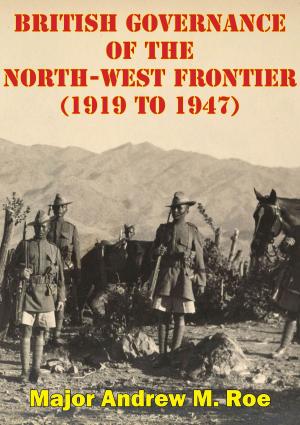The British Colonial Experience In Waziristan And Its Applicability To Current Operations
Nonfiction, History, Middle East, Persian Gulf War, Military| Author: | Matthew Williams | ISBN: | 9781782899938 |
| Publisher: | Tannenberg Publishing | Publication: | November 6, 2015 |
| Imprint: | Tannenberg Publishing | Language: | English |
| Author: | Matthew Williams |
| ISBN: | 9781782899938 |
| Publisher: | Tannenberg Publishing |
| Publication: | November 6, 2015 |
| Imprint: | Tannenberg Publishing |
| Language: | English |
Following the fall of the Taliban government in Afghanistan in late 2001, members of the former regime and Al-Qaeda found refuge in Waziristan. Waziristan is a tribal area in Pakistan located along the border with Afghanistan whose majority ethnic Pashtun population has menaced every occupying power since Alexander the Great. The formidable terrain coupled with the fierce independent character of the Pashtun tribes has made Waziristan a difficult area for outsiders to subdue. Taliban and Al-Qaeda elements use this tribal area as a sanctuary and staging area for attacks against international and government forces in Afghanistan. Waziristan is especially important to the U.S. due to the belief that sympathetic tribesmen may be sheltering Osama bin Ladin and his key lieutenants.
Due to the fact that Waziristan is part of a sovereign country that has forbidden the permanent presence of U.S. troops, the U.S. cannot directly influence this area with overt, uniformed military forces. Despite this challenge, the U.S. is not the first country to try to influence events in Waziristan. When developing the best course of action to accomplish its goals in Waziristan, the U.S. can look to the British colonial experience to help guide its actions. The British dealt extensively with Waziristan from 1849-1947. Despite the passage of time, the most important factors (i.e., political, military, geographical, and ethnographical, etc.) that influenced the British colonial experience have not changed significantly and are still relevant today.
Following the fall of the Taliban government in Afghanistan in late 2001, members of the former regime and Al-Qaeda found refuge in Waziristan. Waziristan is a tribal area in Pakistan located along the border with Afghanistan whose majority ethnic Pashtun population has menaced every occupying power since Alexander the Great. The formidable terrain coupled with the fierce independent character of the Pashtun tribes has made Waziristan a difficult area for outsiders to subdue. Taliban and Al-Qaeda elements use this tribal area as a sanctuary and staging area for attacks against international and government forces in Afghanistan. Waziristan is especially important to the U.S. due to the belief that sympathetic tribesmen may be sheltering Osama bin Ladin and his key lieutenants.
Due to the fact that Waziristan is part of a sovereign country that has forbidden the permanent presence of U.S. troops, the U.S. cannot directly influence this area with overt, uniformed military forces. Despite this challenge, the U.S. is not the first country to try to influence events in Waziristan. When developing the best course of action to accomplish its goals in Waziristan, the U.S. can look to the British colonial experience to help guide its actions. The British dealt extensively with Waziristan from 1849-1947. Despite the passage of time, the most important factors (i.e., political, military, geographical, and ethnographical, etc.) that influenced the British colonial experience have not changed significantly and are still relevant today.

![Cover of the book Hitting Home - The Air Offensive Against Japan [Illustrated Edition] by Matthew Williams](https://www.kuoky.com/images/2015/november/300x300/9781786252432-Mh6l_300x.jpg)




![Cover of the book Wanat : Combat Action In Afghanistan, 2008 [Illustrated Edition] by Matthew Williams](https://www.kuoky.com/images/2014/august/300x300/9781782894940-TjlN_300x.jpg)

![Cover of the book Airborne Operations In World War II, European Theater [Illustrated Edition] by Matthew Williams](https://www.kuoky.com/images/2015/november/300x300/9781786252975-y4Y7_300x.jpg)
![Cover of the book D-Day 1944 - Air Power Over The Normandy Beaches And Beyond [Illustrated Edition] by Matthew Williams](https://www.kuoky.com/images/2014/august/300x300/9781782898870-gH4f_300x.jpg)




![Cover of the book The 1973 Arab-Israeli War: The Albatross Of Decisive Victory [Illustrated Edition] by Matthew Williams](https://www.kuoky.com/images/2015/november/300x300/9781786252791-N1Pw_300x.jpg)
